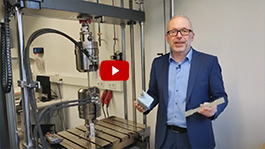Modern manufacturing faces a critical challenge: achieving resource efficiency while managing production irregularities and minimizing product failures. This is particularly true when the behavior of materials under different conditions is a key factor in production outcomes. Identifying innovation opportunities, resolving bottlenecks, and understanding the intricate cause-effect relationships within manufacturing processes require deep insights not only into systems but also into the materials themselves. Moreover, data from multiple sources must be synthesized to uncover hidden material behaviors, predict outcomes, and guide decisions. Without specialized expertise in material science and an understanding of how materials interact within manufacturing systems, these challenges become even more daunting.
Resource Efficient Manufacturing
Why it matters
Material manufacturers across industries face significant challenges in developing and optimizing materials with application-specific properties while addressing broader demands such as transitioning to sustainable production methods. For example, in the steel industry, the push toward carbon-neutral steel intensifies these challenges.
To improve resource-efficient manufacturing and accelerate the development of sustainable materials, it is essential to gather, integrate, and utilize comprehensive information across the entire materials lifecycle. A key complexity lies in managing diverse and dispersed data sources, encompassing everything from raw material properties to process parameters and final component performance , e.g. in terms of sustainability. The relevant data often exists in heterogeneous formats and spans multiple scales, from microstructural details to macroscopic component behavior.
Ensuring interoperability between simulation tools, experimental data, and manufacturing workflows remains critical but challenging. The absence of standardized, semantically enriched data frameworks inhibits efficient integration, traceability, and reuse of knowledge throughout the development chain. As a result, innovation cycles are prolonged, and decision-making processes are often constrained by limited insights and an inability to account for all existing information. This hinders the ability to rapidly bring innovative, resilient materials and components (such as lightweight automotive parts or advanced composites) to the market.
Project Example: StahlDigital
The StahlDigital project addresses these challenges in steel manufacturing by creating ontology based interoperable workflows for the development and optimization of steel materials used in component applications. Focusing on steel sheets for car body parts, the project covers the entire process chain, from semi-finished product manufacturing, through component forming, to crash safety performance.
To address this complexity, StahlDigital employed a bottom up approach to develop a glossary of terms as a basis for ontology creation. This agile methodology allows for iterative refinement and ensures the resulting ontology can adapt to evolving requirements. The glossary includes generalized terms related to material properties, processing steps, and material states across scales (such as component behavior, microstructure, and local chemistry). This groundwork not only supports the development of integrated simulation workflows linked to experimental data and their automated evaluation (including raw measurement data) but also enables the rapid integration of data into a shared dataspace. This, in turn, facilitates the deployment of data-driven applications that derive new insights, accelerate decision-making, and support innovation across the process chain.
By building interoperable workflows based on this ontology, the project paved the way for flexible integration of simulation tools, manufacturing data, and process workflows in our dataspace. The workflows support traceability, enhanced visualization, and data sharing. Tools for simulating materials behavior across different scales can seamlessly be connected. For instance, this allows for the simulation of the manufacturing process of sheet metal components, as demonstrated in StahlDigital.
The effectiveness of these methods is demonstrated through typical use cases from steel research and development, such as evaluating experimental measurements and automated data processing including the identification of material model parameters and conducting simulations to finally analyzing how material and process parameters affect cold rolled steel properties and crash performance. The project is part of the MaterialDigital platform, aiming to make software tools accessible to industry and enabling faster incorporation of new materials and processes into product development.
Overall, StahlDigital establishes the foundation for accelerated innovation in steel materials by combining semantic data frameworks, interoperable workflows, and domain specific expertise, ultimately shortening time to market and supporting sustainable and resilient materials manufacturing processes.
 Fraunhofer Institute for Mechanics of Materials IWM
Fraunhofer Institute for Mechanics of Materials IWM


